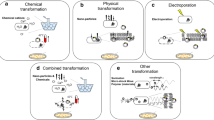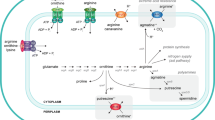Abstract
The broad-spectrum mercury resistance ofStreptomyces lividans 1326 is mediated by six open reading frames (orf). These are arranged in two divergently transcribed operons. Theorfs merA (mercuric reductase) andmerB (organolyase) form one of the two operons. These genes and their regulation were further studied by deletion analysis and transcriptional fusion to the reporter genexylE in the plasmid pXE4. An increase in XylE activity in response to the presence of mercuric ions was observed. The function of ORF2 (MerT) and ORF3 (MerP) as mercury-specific transport proteins, previously postulated based on the structural features of the predicted proteins, was confirmed. Transcription of themer genes starts within the intercistronic region and two divergent promoters were identified by S1 nuclease mapping. Expression of the genes was negatively regulated by the product oforf1, now calledmerR. The repressor function was confirmed by gel retardation assays. MerR, produced inEscherichia coli, bound to two sites (operators) in the fragment containing the promoter region betweenmerA andmerR. Addition of mercuric ions and phenylmercuric acetate prevented the binding of MerR.
Similar content being viewed by others
References
Arnold W, Pühler A (1988) A family of high-copy-number plasmid vectors with single end-label sites for rapid nucleotide sequencing. Gene 70:171–179
Bantleon R, Altenbuchner J, van Pée K-H (1994) Chloroperoxidase fromStreptomyces lividans: isolation and characterization of the enzyme and the corresponding gene. J Bacteriol 176:2339–2347
Bradford MM (1976) A rapid and sensitive method for the quantitation of microgram quantities of protein utilizing the principle of protein-dye binding. Anal Biochem 72:248–254
Chung CT, Niemela SL, Miller RH (1989) One-step preparation of competentEscherichia coli: transformation and storage of bacterial cells in the same solution. Proc Natl Acad Sci USA 86:2172–2175
Degryse E (1990) Influence of the second and third codon on the expression of recombinant hirudin inE. coli. FEBS Lett 269:244–246
Dodd IB, Egan JB (1990) Improved detection of helix-turn-helix DNA-binding motifs in protein sequences. Nucleic Acids Res 18:5019–5026
Eichenseer C, Altenbuchner J (1994) The very large amplifiable element AUD2 fromStreptomyces lividans 66 has insertion sequence-like repeats at its ends. J Bacteriol 176:7107–7112
Griffin H, Foster TJ, Silver S, Misra TK (1987) Cloning and DNA sequence analysis of the mercuric and organomercurial resistance determinants of plasmid pDU1358. Proc Natl Acad Sci USA 84:3112–3116
Hamlett NV, Landale EC, Davis BH, Summers AO (1992) Roles of the Tn21 merT, merP, andmerC gene products in mercury resistance and mercury binding. J Bacteriol 174:6377–6385
Hentschel C, Irminger J-C, Bucher P, Birnstiel M (1980) Sea urchin histone mRNA termini are located in gene regions downstream from putative regulatory sequences. Nature 285:147–151
Hobman J, Kholodii G, Nikiforov V, Ritchie DA, Strike P, Yurieva O (1994) The sequence of themer operon of pMER327/419 and transposon ends of pMER327/419, 330 and 05. Gene 146:73–78
Hopwood DA, Bibb MJ, Chater KF, Kieser T, Bruton CJ, Kieser HM, Lydiate DJ, Schrempf H, Smith CP, Ward JM (1985) Genetic manipulation ofStreptomyces: a laboratory manual. The John Innes Foundation, Norwich
Hopwood DA, Kieser TR, Wright HM, Bibb MJ (1983) Plasmids, recombination and chromosome mapping inStreptomyces lividans 66. J Gen Microbiol 129:2257–2269
Huckle JW, Morby AP, Turner JS, Robinson NJ (1993) Isolation of a prokaryotic metallothionein locus and analysis of transcriptional control by trace metal ions. Mol Microbiol 7:177–187
Ingram C, Brawner M, Youngman P, Westpheling J (1989)xylE functions as an efficient reporter gene inStreptomyces spp.: use for the study ofgalP1, a catabolite-controlled promoter. J Bacteriol 171:6617–6624
Ji G, Silver S (1992) Regulation and expression of the arsenic resistance operon fromStaphylococcus aureus plasmid pI258. J Bacteriol 174:3684–3694
Kieser T (1984) Factors affecting the isolation of ccc DNA fromStreptomyces lividans andEscherichia coli. Plasmid 12:19–36
Kondorosi E, Pierre M, Cren M, Haumann U, Buire M, Hoffmann B, Schell J, Kondorosi A (1991) Identification of NolR, a negative trans-acting factor controlling thenod regulon inRhizibium meliloti. J Mol Biol 222:885–896
Laemmli UK (1970) Cleavage of structural proteins during assembly of the head of bacteriophage T4. Nature 227:680–685
Maxam AM, Gilbert W (1977) A new method for sequencing DNA. Proc Natl Acad Sci USA 74:560–564
Misra TK (1992) Bacterial resistance to inorganic mercury salts and organomercurials. Plasmid 27:4–16
Nakahara H, Silver S, Miki T, Rownd RH (1979) Hypersensitivity to Hg2+ and hyperbinding activity associated with cloned fragments of the mercurial resistance operon of plasmid NR1. J Bacteriol 140:161–166
Rosenstein R, Peschel A, Wieland B, Götz F (1992) Expression and regulation of the antimony, arsinite and arsanate resistance operon ofStaphylococcus xylosus plasmid pSX267. J Bacteriol 174:3676–3683
Sambrook J, Fritsch FE, Maniatis T (1989) Molecular cloning: a laboratory manual (2nd edn). Cold Spring Harbor Laboratory Cold Spring Harbor, Press, New York
San Francisco MDJ, Hope CL, Owolabi JB, Tisa LS, Rosen BP (1990) Identification of the metalloregulatory element of the plasmid-encoded arsenical resistance operon. Nucleic Acids Res 18:619–624
Sedlmeier R, Altenbuchner J (1992) Cloning and DNA sequence analysis of the mercury resistance genes ofStreptomyces lividans. Mol Gen Genet 236:76–85
Shewchuk LM, Verdine GL, Walsh CT (1989) Transcriptional switching by the metallo-regulatory MerR protein: initial characterization of DNA and mercury (II) binding activities. Biochemistry 28:2331–2339
Silver S, Walderhaug M (1992) Gene regulation of plasmid- and chromosome-determined inorganic ion transport in bacteria. Microbiol Rev 56:195–228
Strohl WR (1992) Compilation and analysis of DNA sequences associated with apparent streptomycete promoters. Nucleic Acids Res 20:961–974
Studier FW, Rosenberg AH, Dunn JJ, Dubendorf JW (1990) Use of T7 RNA polymerase to direct expression of cloned genes. Methods Enzymol 185:60–89
Summers AO (1992) Untwist and shout: a heavy metal-responsive transcriptional regulator. J Bacteriol 174:3097–3101
Tautz D, Renz M (1983) An optimized freeze-squeeze method for the recovery of DNA fragments from agarose gels. Anal Biochem 132:14–19
Thomas PS (1980) Hybridization of denatured RNA and small DNA fragments transferred to nitrocellulose. Proc Natl Acad Sci USA 77:5201–5205
Wada K, Wada Y, Ishibashi F, Gojobori T, Ikemura T (1992) Codon usage tabulated from GenBank genetic sequence data. Nucleic Acids Res 20:2111–2118
Yanisch-Perron C, Vieira J, Messing J (1985) Improved M13 phage cloning vectors and host strains: nucleotide sequences of the M13mp18 and pUC19 vectors. Gene 33:103–119
Yu H, Mukhopadhyay D, Misra TK (1994) Purification and characterization of a novel organometallic receptor protein regulating the expression of the broad spectrum mercury resistant operon of plasmid pDU1358. J Biol Chem 269:15697–15702
Author information
Authors and Affiliations
Additional information
Communicated by J. W. Lengeler
Rights and permissions
About this article
Cite this article
Brünker, P., Rother, D., Klein, J. et al. Regulation of the operon responsible for broad-spectrum mercury resistance inStreptomyces lividans 1326. Molec. Gen. Genet. 251, 307–315 (1996). https://doi.org/10.1007/BF02172521
Received:
Accepted:
Issue Date:
DOI: https://doi.org/10.1007/BF02172521




